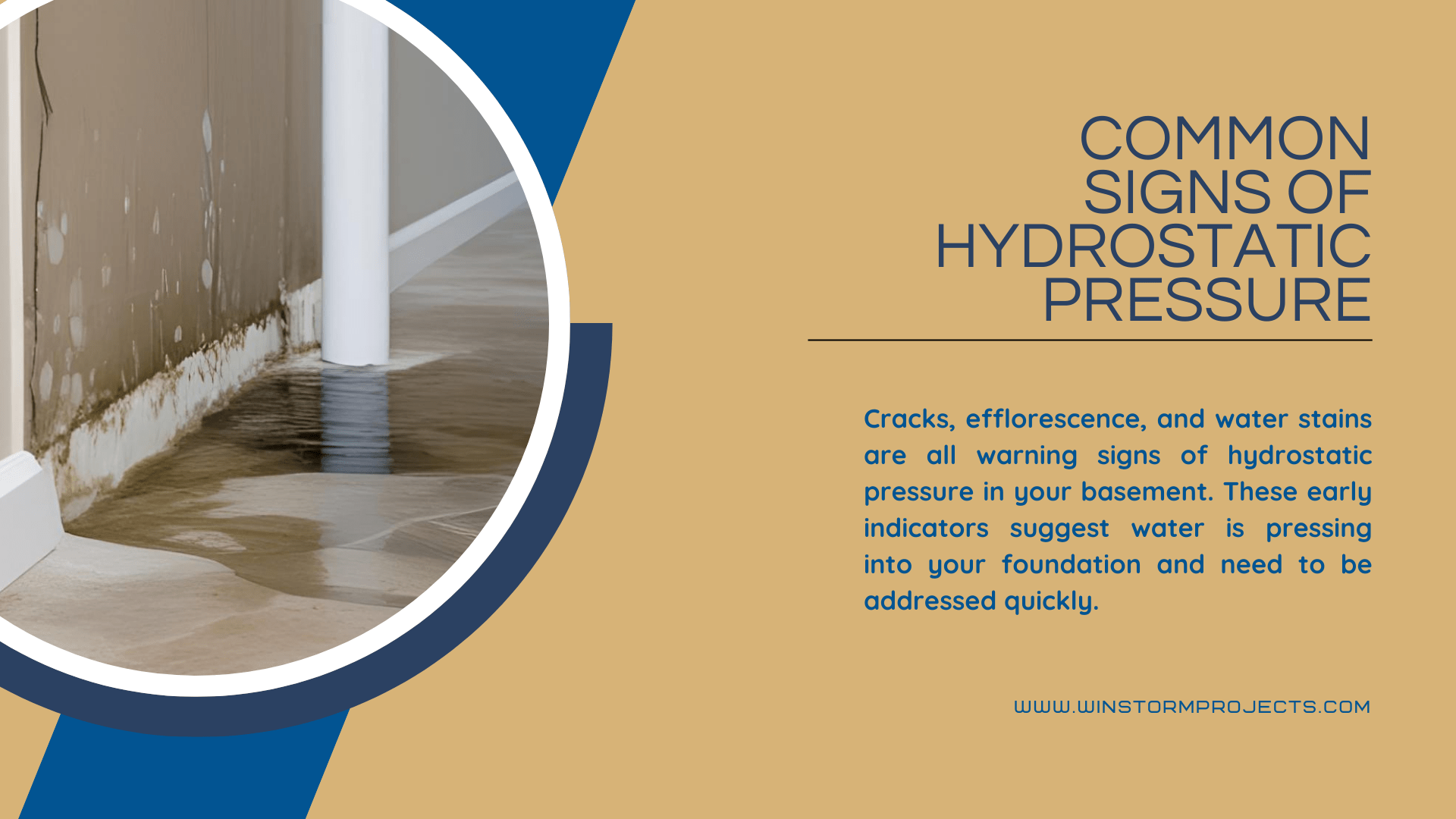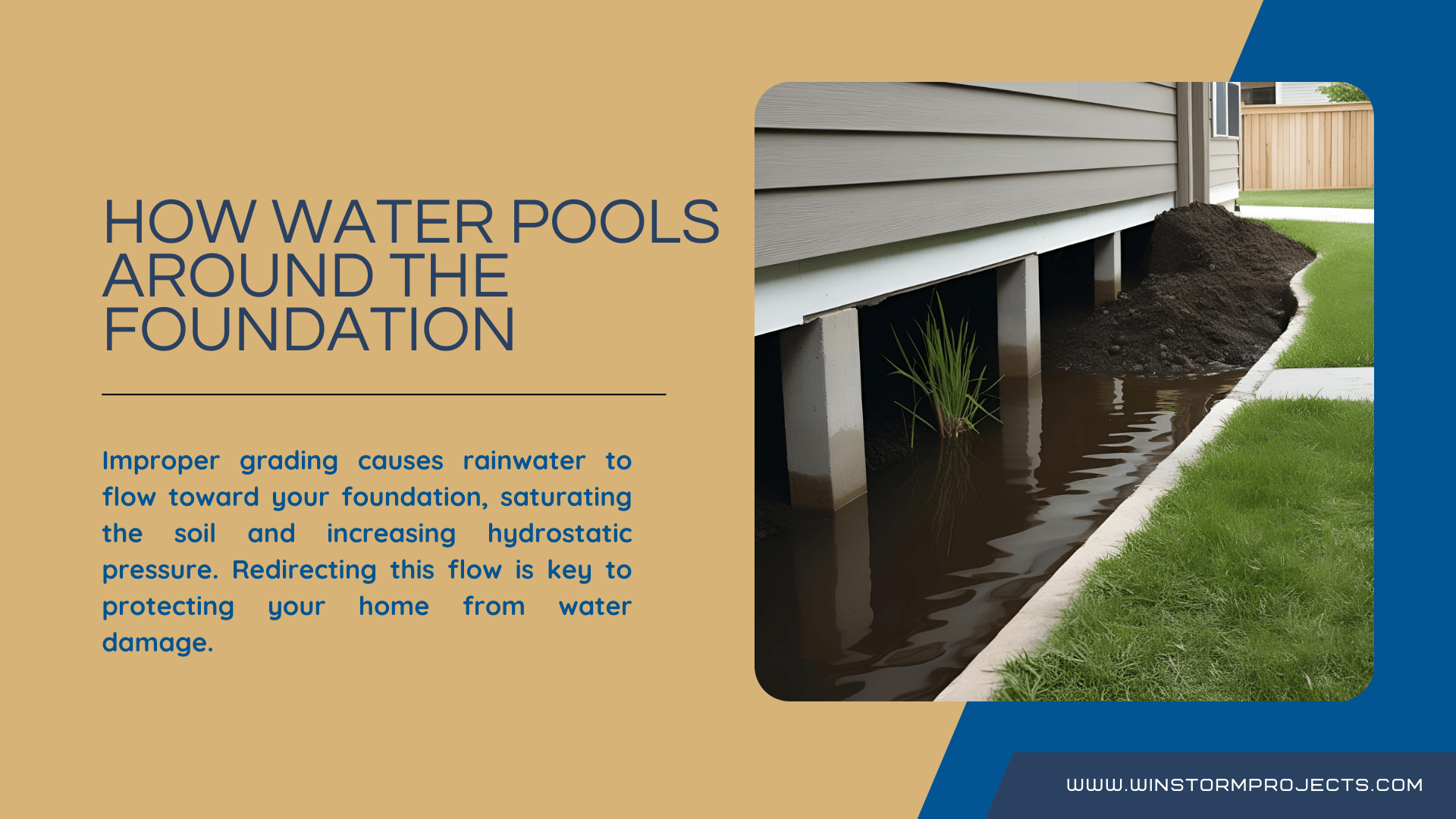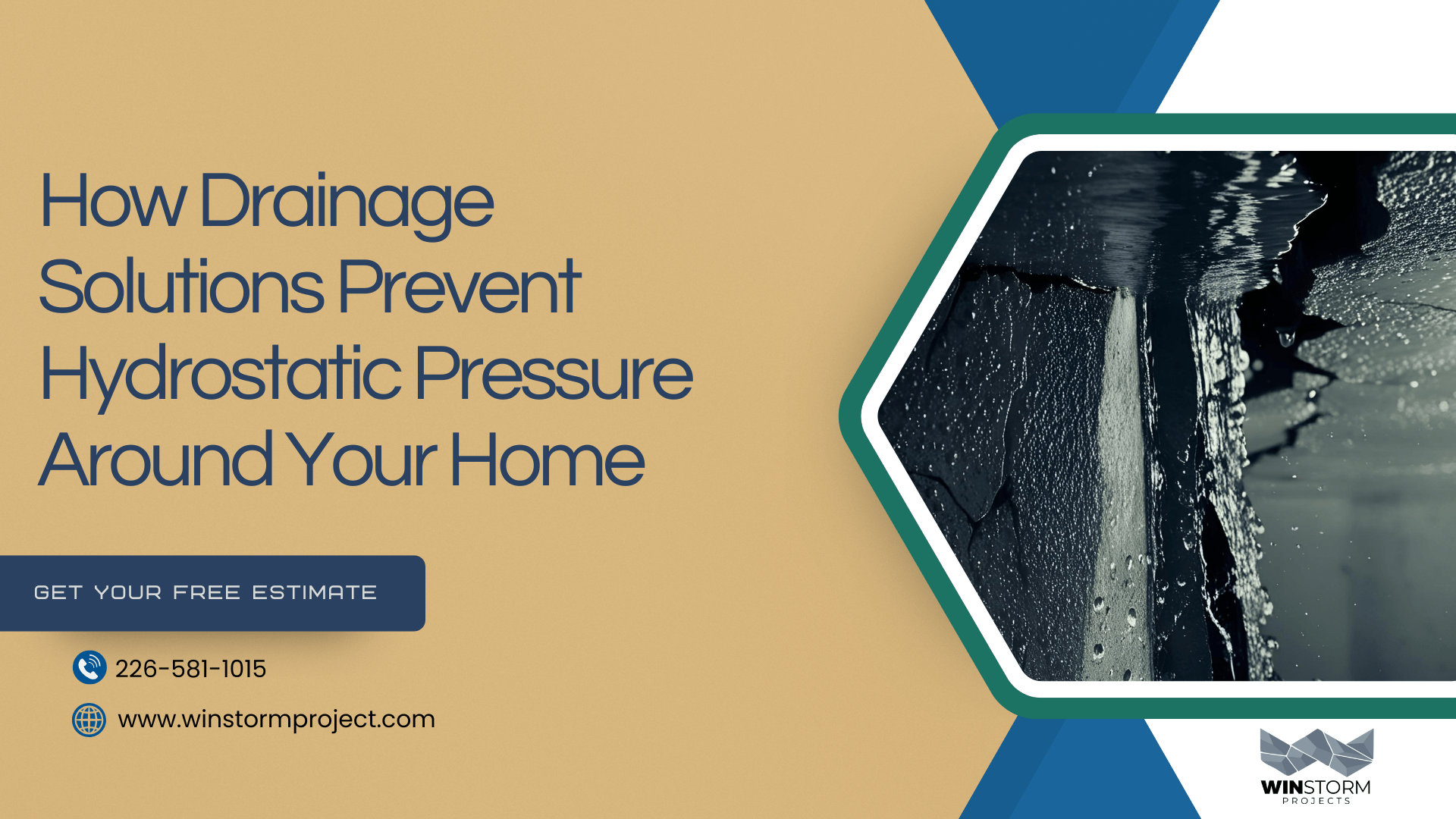Hydrostatic pressure can be a serious issue for any homeowner. When water builds up in the soil around your home, it exerts pressure on your foundation walls—especially your basement walls. Left unchecked, this pressure can cause cracks, bulging, and even basement flooding. To protect your home from water damage and structural issues, proper drainage systems are essential.
In this post, we’ll break down how hydrostatic pressure forms, what signs to look for, and which drainage solutions help relieve hydrostatic pressure around your basement before it causes lasting damage.
What Is Hydrostatic Pressure and Why It Matters
Hydrostatic pressure is the force exerted by water in the soil as it builds up around your home’s foundation. After heavy rain or snowmelt, water accumulates around the foundation. If your yard doesn’t drain well, this water has nowhere to go. Instead, it begins to press against your foundation walls and floor.
This pressure can force water through cracks or weak points in your basement or crawl space, leading to moisture intrusion, wall efflorescence (that white, chalky residue), and eventually serious structural issues.
How Hydrostatic Pressure Builds Beneath Your Home
Hydrostatic pressure builds when water in the soil around your home can’t drain properly. This is especially common in areas with a high water table or poor soil drainage. Over time, saturated soil pushes against basement walls and floor slabs. As the pressure increases, it can cause foundation cracks or force water into the basement through any available opening.
The more water that accumulates, the more intense the pressure becomes. And unlike surface water, this subsurface force is persistent—it won’t go away on its own.
The Impact of Hydrostatic Pressure on Basements
Basement walls are especially vulnerable to hydrostatic pressure. Over time, the force can lead to:
- Cracks in the foundation
- Water leaks or damp spots inside your basement
- Bulging basement walls
- Efflorescence from trapped moisture
- Structural weakening
Ignoring these issues can compromise the stability of your home, making early intervention critical.
What Causes Hydrostatic Pressure?
Understanding what causes hydrostatic pressure helps you tackle it at the source. Common culprits include:
- Poor yard grading that slopes toward your home
- Short or poorly placed downspouts that dump water near your foundation
- Clogged or missing drainage systems
- Heavy, consistent rainfall in areas with poor drainage
- A high water table beneath your property
When the soil around your home stays saturated, it creates a constant push against the basement walls—known as hydrostatic pressure.
Signs of Hydrostatic Pressure Around Your Basement
You may not see hydrostatic pressure itself, but you’ll definitely see its effects. Watch for:

- Cracks in the foundation or basement walls
- Water stains on basement walls or floors
- Efflorescence (white powdery residue on concrete)
- Musty odours or persistent dampness
- Standing water or soggy patches near your foundation
- Bulging walls or shifting floor slabs
These signs often mean the pressure against the foundation walls has built up enough to breach the structure. If you notice them, it’s time to act.
How Poor Drainage Contributes to Hydrostatic Pressure
Without a proper drainage system, water has nowhere to go but into the soil around your home. That’s when it begins to exert pressure on the foundation, creating ideal conditions for leaks and damage.
Water Pooling Near the Foundation

Pooling water is one of the earliest signs of a drainage problem. Whether caused by improper grading or short downspouts, water that collects around the foundation soaks into the soil and creates hydrostatic pressure.
Soggy Lawns and Yard Drainage Issues
Soft, muddy lawns or standing water after rain are signs your drainage system isn’t working. These conditions point to soil that can’t handle excess water, which increases the risk of water entering your basement and damaging the foundation.
Grading and Downspouts: Your First Line of Defense
Proper grading ensures water flows away from your home, not toward it. Similarly, longer downspouts carry roof runoff far enough to prevent water from saturating the soil around your foundation.
These are simple fixes that can dramatically reduce basement water issues and help prevent hydrostatic pressure from forming in the first place.
Drainage Solutions That Prevent Hydrostatic Pressure
A well-designed drainage system doesn’t just keep your yard dry—it can relieve hydrostatic pressure and protect your basement from long-term damage. Here are the most effective solutions:
French Drains

A French drain is a trench filled with gravel and a perforated pipe that redirects subsurface water away from the foundation. This system helps prevent water from pooling around your home and can alleviate hydrostatic pressure before it becomes a problem.
Weeping Tile Systems
Weeping tiles (also known as drain tile systems) are installed around the perimeter of your home. They collect groundwater and channel it to a sump pump or storm drain. This helps manage high water levels in the soil and prevents water from entering your basement.
Grading Adjustments
By correcting your yard’s slope, you can keep water moving away from the home instead of toward it. This prevents soil saturation and reduces hydrostatic pressure. In many cases, grading adjustments are one of the most affordable and effective solutions.
When to Call for Professional Help
If you see cracks in the foundation, bulging basement walls, or water stains, it’s time to speak with a foundation repair specialist or basement waterproofing contractor.
At WinStorm Projects, we help homeowners across Guelph and Kitchener assess their properties, diagnose the causes of hydrostatic pressure, and implement tailored drainage system solutions to protect your home from water damage.
Ignoring the effects of hydrostatic pressure can lead to costly repairs down the line. But with a proactive approach, you can keep your basement dry and protect the structural integrity of your home.
Conclusion
Hydrostatic pressure isn’t just a plumbing issue—it’s a structural threat. If water is allowed to build up around your basement, it can force its way inside, cause cracking, and weaken your foundation over time.
By investing in a proper drainage system, correcting grading, and installing options like French drains or weeping tile systems, you can prevent hydrostatic pressure from damaging your property.
If you’re seeing any signs of hydrostatic pressure or just want to ensure your exterior drainage system is working properly, reach out to the team at WinStorm Projects. We offer expert advice and custom foundation repair solutions that keep your home dry, safe, and stable.
Frequently Asked Questions
What causes hydrostatic pressure issues in basements?
Hydrostatic pressure is usually caused by excess water in the soil around your foundation—often due to poor grading, clogged drains, or a high water table. This pressure can lead to cracks in the foundation or water entering your basement.
How can I tell if I have a drainage problem?
Look for signs like standing water, soggy lawns, or water stains inside your basement. These are indicators that water isn’t flowing away from your foundation properly.
What are the most effective ways to relieve hydrostatic pressure?
Installing a French drain, correcting your yard’s grading, and using weeping tile systems are highly effective at reducing hydrostatic pressure and preventing water intrusion.
When should I call a professional?
If you notice persistent leaks, foundation cracks, or any sign of basement flooding, it’s time to consult a basement waterproofing specialist or foundation repair expert.
What role do downspouts play in drainage?
Properly extended downspouts direct water away from the home, preventing it from pooling near the foundation and contributing to hydrostatic pressure.
What’s the difference between interior and exterior drainage systems?
Exterior drainage systems, like French drains, manage water before it reaches your foundation. Interior drainage systems collect water that’s already entered your basement. Both are important but serve different purposes.

